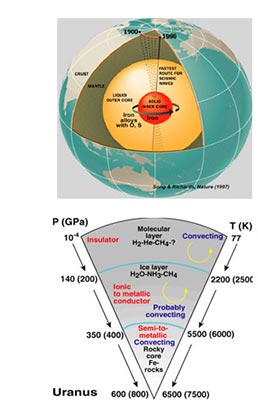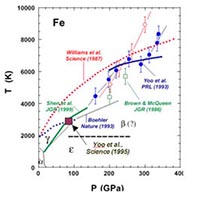The core and mantle of the Earth and neighboring planets are made of relatively simple materials, but at very high pressures and temperatures. Therefore the laser-heated diamond anvil high pressure technique provide a unique way to learn about the chemical composition, internal structure, energy balance, magnetism, and the exact states of major constituents.
For example, iron is the dominant element of the Earth's core, and therefore the determination of its phase diagram at high pressures and temperatures is central to understanding a large number of properties and processes of the planet's deep interior, including its temperature profile, chemical composition, energy balance, dynamics, and geomagnetism. For this reason, there have been numerous studies for understanding the phase diagram of iron. In fact, current constraints on the iron phase diagram under Earth core conditions heavily rely on diamond anvil cell (DAC) and shock wave results, as summarized in the figure.
A laser-heated DAC is capable of reaching the P,T conditions of the center of the Earth and the deep interiors of Jovian planets. By combining the laser-heated DAC technique with synchrotron x-ray diffraction and laser-spectroscopic methods, we aim to understand the exact physical and chemical states of major constituents of Earth and the Jovian planets at high pressures and temperatures. The materials under current investigation range from hydrogen to planetary ices like water and methane to Fe and Fe-bearing oxides (See Yoo et al., Science 270, 1473 (1995) and PRL 70, 3931 (1993)).






